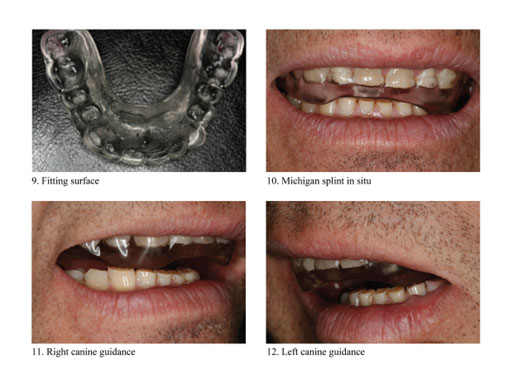What are the occlusal splints?
The Michigan, Repositioning, and Relaxation splints are full-coverage heat-cured hard acrylic occlusal splints custom-made appliances to treat conditions such as temporomandibular joint disorders (TMJD), bruxism (teeth grinding) and related issues.
These splints benefit individuals suffering from TMJD, bruxism, or related conditions. They aim to alleviate symptoms, protect teeth, and improve jaw function and comfort.
What are the indications of occlusal splints?
- Diagnosis and management of parafunction, severe bruxism and Pain Dysfunction Syndrome (PDS) caused by increasing muscle relaxation (relaxation splint).
- Determination of the central jaw relationship (RCP) following reduced muscle hyperactivity and mandibular repositioning (relaxation/internal derangement splint).
- Diagnosis and treatment of traumatic occlusion to any part of the masticatory system.
- Assessment and successive alteration of the vertical dimension of occlusion.
- Management of severe attrition before the prosthodontic rehabilitation phase.
- Protection of the teeth and restorations from undue deflective parafunctional activity could cause excessive occlusal/bite forces.
- Temporary disclusion/distancing of arches during orthodontics to avoid clutches during jaw movements.
- Post-orthodontic tooth stabilisation is used as a retention device.
- Reduction of the masticatory forces and treatment of patients with tension-headache (relaxation splint).
- Habitual teeth grinding or bruxism: Unintentional, forceful teeth grinding, especially while asleep, wears off the enamel. Some people with psychological stress and insecurities tend to grind their teeth even during the day. Such patients need simultaneous psychiatric support to eliminate the bruxism habit.
Occlusal splints, also known as bite splints or occlusal guards, are dental appliances designed to address various issues related to the alignment and function of the teeth and jaws. They come in different types and serve other purposes, including:
Stabilisation splint
This type of occlusal splint is designed to stabilise the jaw and prevent excessive mandibular movement, particularly during sleep. It is often used in cases of excessive jaw joint mobility or when the teeth and TMJ need to be protected from the effects of parafunctional habits like bruxism (teeth grinding) or clenching.
The stabilisation splint is similar to the relaxation splint in that it provides a protective barrier between the upper and lower teeth to prevent damage caused by grinding and clenching.
Stabilisation splints can help reduce muscle fatigue and soreness, alleviate jaw pain, and protect the teeth from wear and damage by stabilising the jaw and limiting excessive movement.
Night Guards/Relaxation Splints
These splints are primarily used to protect the teeth from the damaging effects of bruxism (teeth grinding) and clenching during sleep. They provide a cushioning barrier between the upper and lower teeth, absorbing the forces generated during grinding and preventing wear on the tooth enamel and dental restorations. They may also help reduce muscle tension in the jaw.
Repositioning Splint
This splint is designed to reposition the jaw to a more optimal alignment. It’s commonly used for patients with TMD, where jaw misalignment contributes to symptoms. Gradually adjusting the jaw’s position aims to relieve pain and improve function.
Relaxation Splint
This splint is primarily used to prevent teeth grinding and clenching (bruxism) during sleep. Providing a barrier between the upper and lower teeth helps to protect the teeth from damage caused by grinding and may also reduce muscle tension in the jaw.
Michigan Splint
A Michigan splint is a removable oral appliance that covers the biting surfaces of all the teeth in either the upper jaw or lower jaw.
The Michigan splint is a specific occlusal splint designed to reposition the jaw to a more optimal alignment, mainly to alleviate temporomandibular joint disorders (TMD). It works by gradually adjusting the position of the lower jaw to relieve strain on the temporomandibular joint and surrounding muscles, thereby reducing symptoms such as jaw pain, clicking, and limited movement.
Maxillary stabilisation appliances, also known as Michigan splints, and mandibular stabilisation appliances, known as Tanner appliances, are the most commonly prescribed stabilisation splints. The Michigan splint is a specific type of occlusal splint designed to reposition the jaw to a more optimal alignment, particularly in temporomandibular joint disorders (TMD). It works by gradually adjusting or stabilising the position of the lower jaw to the most comfortable position to alleviate strain on the temporomandibular joint and surrounding muscles, thereby reducing symptoms such as jaw pain, clicking, and limited movement.
Request an Appointment
What are the advantages of the Michigan occlusal splint?
- As it is a cost-efficient full-coverage appliance, it is considered a reversible and efficacious treatment modality as it does not induce unwanted tooth movement and malocclusion.
- It produces an ideal removable occlusion that may effectively manage TMJ dysfunction in the pre- and post-restorative phases of treating worn and mutilated dentition.
- It offers dimensional adaptability as it does not interfere with swallowing, normal lip seal and speech.
- It is well-retained and covers the minimum amount of soft tissue compatible with biological health.
- It provides adequate strength, function and patient tolerance.
- It can protect all types of restorations.
- It allows the condyles to seek an optimal position in centric relation before definitive occlusal therapy.
- The patient usually becomes pain-free after a few days or weeks.
- It can be used indefinitely without causing a change in occlusal relations.
What are the disadvantages of the Michigan occlusal splint?
- The occlusal adjustment may be time-consuming and require long sessions.
- May develop dependence tendency in patients with TMJD.
What are the clinical and laboratory procedures for planning and fabrication of the Michigan occlusal splint?
These clinical procedures ensure that the Michigan splint is custom-made to fit the patient’s unique dental anatomy and provide effective treatment for TMJ disorders and bruxism.
Patient Examination:
We assess your dental and medical history and symptoms and perform a comprehensive clinical examination to evaluate the temporomandibular joint and occlusion condition.
Intraoral scanning of the upper and lower arches and the bite registration at the desired vertical and natural jaw relation are taken.
Fabrication:
The Michigan splint is made of hard acrylic. It is custom-made based on the patient’s dental impressions and bite registration.
The splint should provide adequate retention while being comfortable to insert and remove. The splint should offer multiple bilateral posterior even contacts with equal intensity in different jaw positions to allow interference-free jaw movement. Canine guidance/protection should be provided during lateral excursive movement in the lower jaw while maintaining posterior tooth disclusion. During the protrusive excursion, smooth and shallow anterior guidance should maintain lasting posterior disclusion. A shallow, smooth, concave ramp in the anterior region provides posterior disclusion during mandibular excursive movements.
Adjustments:
The appliance is fabricated and sent to the dentist for a try-in and final bite adjustment to ensure proper fit and comfort. This may involve trimming or reshaping the splint to eliminate any pressure points and ensure even contact with the teeth.
Delivery and Instructions:
The patient will be provided instructions on properly wearing and caring for the splint. Patients are typically instructed to wear the splint at night or during times of stress to alleviate symptoms associated with TMJ disorders and bruxism.
Follow-Up:
Careful control of patients with aggressive bruxism is mandatory. Therefore, the patient should be scheduled for follow-up appointments to make any necessary adjustments. The patient should be monitored monthly after that to control discomfort and possible adjustment and evaluate the effectiveness of the Michigan splint. The duration of treatment of patients with pain dysfunction syndrome should be at most six months.
9 Tips to correctly use a Michigan splint
- The dental splint is usually worn at night, as most people grind their teeth while sleeping.
- Ensure the splint and your teeth are very clean before you wear the splint.
- Do not consume food or drinks other than water once the splint is in place.
- Ensure that the splint clicks securely over your teeth.
- Brush your splint with soap over a water basin in the morning.
- Do not use toothpaste as it can scratch the appliance.
- Please don’t wash it with warm water. It can change shape, and the splint will no longer fit your teeth.
- Place the splint in a mild sterilisation solution like denture cleaner or baby bottle cleaning fluid once a week.
- Always store the splint in a dry place away from pets and children.
FAQ – What do patients usually ask about occlusal splints?
- Class III jaw relationship or under-bite to avoid a large anterior projecting labial surface of splint which would not be tolerated.
- Mobile teeth in the lower arch.
- Several missing teeth in the lower arch.
- Myo-clench inhibitor (MCI) is a comfortable occlusal splint designed to reduce headache, bruxism, and TMJ disorders.
- MCI protects the teeth from wear and attrition and prevents teeth and restorations from cracking and chipping.
- MCI does not interfere with sleep while preventing nocturnal teeth, grinding alleviating jaw and neck pain.
- In porcelain or implant-supported restorations, MCI could be fabricated with an extra internal soft-lining layer acting as a shock-absorber and providing more efficient protection against biomechanical overloading as well as patient comfort.
- The occlusal scheme is designed so that the splint contacts mainly the lower incisors and, to some extent, canines during the anterior and lateral excursive contact movements (anterior resp. canine guidance) while minimising the occlusal contacts on the 1st premolars.
- In the anterior region, the splint is designed with a “guidance ramp” to encourage patients to bite into the correct bite, while its unique shape of comfort plane allows more tongue space.
- Patients are treated based on their presented complaints from minor TMJDS caused by nocturnal parafunctional activities.
Soft Nightguards are different from rigid Michigan splints because they are made of soft polymers. In contrast, Michigan splints are made of hard acrylic material and are more complex to fabricate.
Night guards are not recommended in patients suffering from para-functional activities as they exacerbate masticatory overloading and parafunction.
A dental Tanner’s Splint or appliance is an orthodontic appliance used to treat temporomandibular joint dysfunction syndrome (TMJDS).
The Tanner splint could consist of an acrylic plate that fits over the upper or lower teeth, sometimes both, and is connected by metal arms to create a bite block. This design helps stabilise the jaw and facilitate the jaw-joint alignment to alleviate symptoms such as jaw pain, headaches, clicking or luxation of the lower jaw.
This appliance is also part of a comprehensive intervention or jaw-deprogramming orthodontic treatment pre-planning to address TMJDS or correction of malocclusions.
These splints are used for diagnostic purposes to evaluate the occlusion (bite) and jaw relationship. They are often used during occlusal analysis and bite registration procedures to assess the contact position and relationship during functional jaw movement.
Orthodontic splints align the teeth into the desired position, expand the dental arch, correct bite alignment, or facilitate tooth movement.
Functional appliances are a type of occlusal splint used in orthodontics to modify jaw growth and correct bite discrepancies, particularly in growing children and adolescents. They work by influencing the position and function of the jaws to achieve improved facial harmony and bite alignment.
Overall, occlusal splints play diverse roles in dentistry, from protecting teeth and relieving jaw pain to aiding orthodontic treatment and diagnosing occlusal issues. They are custom-made to fit each patient’s mouth and are fabricated based on specific treatment goals and requirements.
Occlusal Splint Case Studies
See our occlusal splint before and after photos from our happy patients.

Before and After Treatment
Diagnosis and management of parafunction and bruxism.

Before and After Treatment
Management of Pain Dysfunction Syndrome by increasing muscle relaxation.


